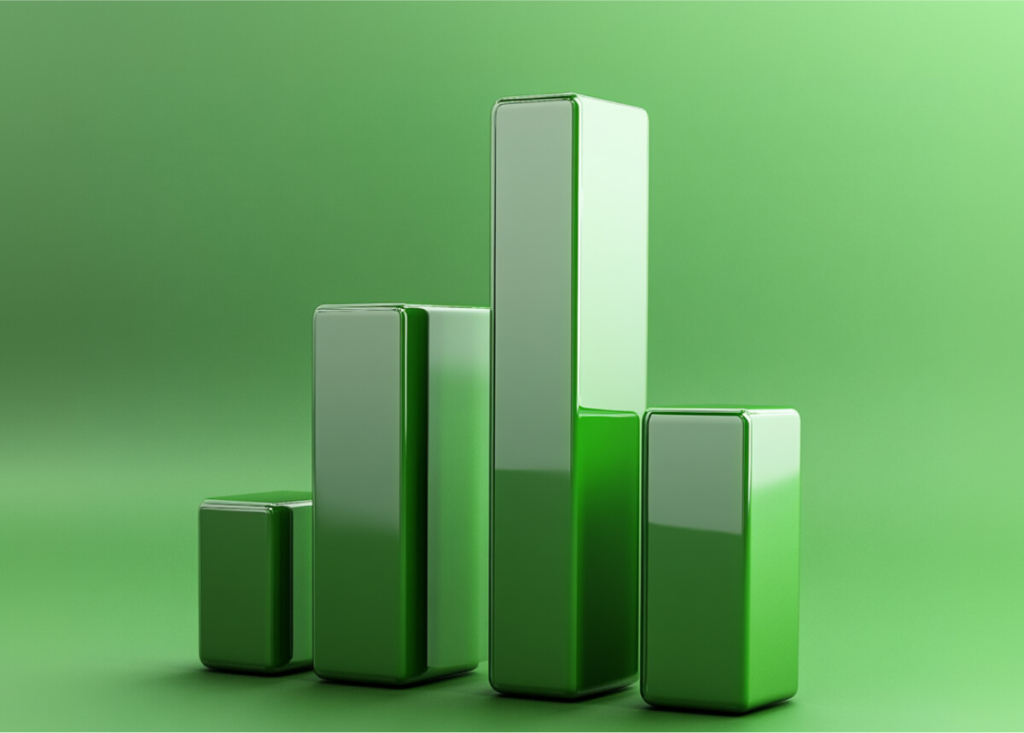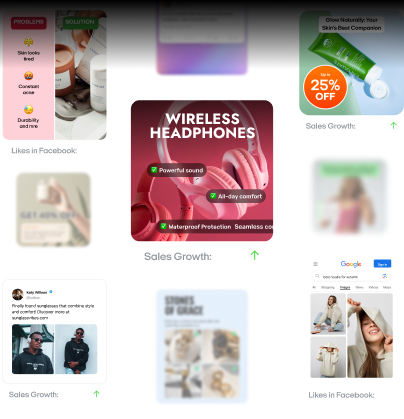3 ways AI in programmatic advertising helps you spend less on ads
Discover 3 ways AI in programmatic advertising helps cut costs, boost targeting, and improve ad performance with real-time data insights.
You’ve probably noticed how some advertisers still use outdated bidding and targeting methods. That wastes budget, misses conversions, and leads to generic messaging. AI in programmatic advertising changes that by harnessing data-driven insights to deliver relevant and personalized campaigns in real time.
Global programmatic ad spend reached $595 billion in 2024, heading toward $800 billion by 2028. This growth underscores the value of machine learning, ad optimization, and real-time bidding AI.
Mixing these tools with predictive analytics in digital ads sharpens audience segmentation, supports dynamic creative optimization, and increases revenue potential. Artificial intelligence powers programmatic ad buying through automated bidding and ad performance optimization.

Use AI to make ads smarter and manageable
AI in programmatic advertising uses machine learning, predictive analytics, and real-time bidding to automate ad buying. It analyzes user data to improve targeting, place impressions at the right time, and help you control budgets, creativity, and audience selection with no guesswork. AI ad generator creates and optimizes ad creatives automatically, making the process faster and more effective.
AI speeds and improves your ad strategy
Your audience moves fast — scrolling social media one minute, reading reviews the next. Programmatic advertising based on manual segmentation can’t keep up. AI tracks these shifts in real time, improving bid management and targeting. Brands using automated ad buying often see lower CPA and faster optimization.
But AI doesn’t mean letting go of the reins. You set your rules, like targets or maximum bids, and AI does the heavy lifting. You get to concentrate on strategy, storytelling, and creative optimization. Think of AI like your full-time analyst who sifts through data so you don’t have to.
Before AI, you manually adjusted bids and hoped your segments worked. With AI in programmatic advertising, campaigns run on a feedback loop. Every interaction powers real-time bidding, sending your budget to top placements. Dynamic creative optimization then personalizes your ads based on each viewer’s profile.
How AI handles bidding and personalization
Predictive analytics looks at past data to guess who’ll convert or which hours see the most activity. You can schedule your ads for moments when people pay the most attention. NLP digs deeper than simple keywords. It determines user intent by scanning search terms, social posts, or other browsing signals.
If someone’s checking out “budget-friendly tropical vacations,” NLP might instantly show a headline like “Ready for a Sunny Island Getaway?” instead of a random tagline. This personalization happens right away and gives you more chances to connect.
AI isn’t hype, it’s how smart brands win in a fast-paced world. You still control the creative, while AI improves targeted digital advertising and reduces wasted impressions. No data science team needed. Most demand-side platforms have AI built in, so you can optimize, monitor, and scale your ads in just a few clicks.
Embracing AI for real impact
When you add AI to your programmatic marketing plan, you stay ahead of shifting consumer habits and target the right people. Aim for brand awareness, higher conversions, or better audience segmentation by letting machine learning do the heavy lifting. Test new creative formats, track results, and let AI guide your next move.
When you add AI to your programmatic marketing plan, you target the right people easily. Aim for brand awareness, conversions, or stronger audience segmentation while machine learning handles the heavy lifting. Test new creative formats, track performance, and let AI guide your next smart move.
AI and ML make ads smarter and easier
Machine learning for ad is sophisticated, intelligent, and mostly automated in helping today’s best ad strategies succeed. They handle everything from pinpointing your ideal audience to fine-tuning bids and testing creative. This reduces guesswork and allows for data-driven decisions to reach the right people.
What Is Artificial Intelligence and Machine Learning
Artificial Intelligence covers systems that learn or make decisions without you hovering over every detail. Machine Learning is the branch of AI built for detecting patterns and making predictions.
Deep learning is an advanced form of ML that mimics how the brain spots patterns. It tracks how long viewers watch your ad, which scenes get clicks, and learns from your campaign data. Instead of using generic rules, the algorithm predicts who’s likely to convert, getting smarter with every ad you run or update.
NLP is a specialized AI field that interprets text or speech and adjusts ad messaging in real time. If someone searches “affordable tropical vacations,” NLP detects intent and delivers a personalized headline. This fast personalization helps you reach people with no guesswork. The system tailors your ads automatically.
How AI and ML improve your ad campaigns
AI, ML, deep learning, and NLP work together to power programmatic ads. Your campaigns adjust bids automatically as user behavior shifts. With each impression or click, the system learns and improves. Even small businesses can access this automation through trusted platforms, no massive tech budget required.
With AI and ML taking care of tedious optimization tasks, you focus on bigger goals. You can map out creative concepts, build your brand story, and let the technology handle cost-per-click and real-time ad placements. That means fewer wasted impressions, quicker pivots, and a clear path to consistent ROI.
You might be spending hours tweaking bids and choosing audience segments by hand. But when you switch to AI, you can automate and optimize these tasks around the clock. This data-driven approach reacts in milliseconds whenever user behavior or market conditions change.
You’re no longer stuck waiting for next-day performance reports — AI updates your strategy as it happens. Unlike a manual system, which can miss sudden shifts, an AI solution looks for new signals constantly and pivots your campaigns in near-real time.
An AI platform gathers data like real-time user behavior, device, and location signals. It uses LSI to understand keyword context and audience intent. Over time, it learns micro-trends, like which demographics perform best when. You get data-driven insights that show where your budget will make the biggest impact.
Once the system identifies a promising ad impression, it applies automated bidding strategies to win that spot at just the right price. Real-time bidding means the platform calculates an ideal bid in a split second, which is high enough to secure the placement but still mindful of your maximum spending limits.
If you’ve ever worried about overspending, you can set guardrails like target cost-per-acquisition or daily budgets. Intelligent algorithms handle everything, so you don’t have to make last-minute changes. The platform monitors performance and adjusts your bids.
The more your campaigns run, the more the system refines audience segmentation. It looks for patterns in user interactions, cross-device behavior, and purchase history. It may also apply NLP to interpret the language in searches, reviews, or social posts.
By zeroing in on these signals, you get ad targeting precision without having to parse manually. Over time, the platform filters out low-performing segments and concentrates your ad spend where it produces the highest return.
AI makes smart changes while you work
With AI, your campaigns stay dynamic. The system monitors KPIs like CPC and CPA in near-real time. If clicks drop, it tests new headlines or creatives. When segments underperform, it lowers bids automatically. Such data-driven performance management lets you focus on high-level strategy while AI handles optimization.
Why more advertisers are moving to AI
According to eMarketer, programmatic will account for 96.8% of new display ad dollars in 2025. This dominance stems from advertisers seeking AI-driven buying platforms that automatically allocate budgets to high-potential inventory. No matter the size of your business, automation is growing in importance.
How you can start small and still stay in control
If you’re new to AI or have a modest budget, don’t worry. Platforms like Google Ads, Meta Ads Manager, and major DSPs offer built-in machine learning tools for any campaign size. You set limits and test AI against manual campaigns. It runs faster, saves time, and drives growth with instant, data-driven decisions.
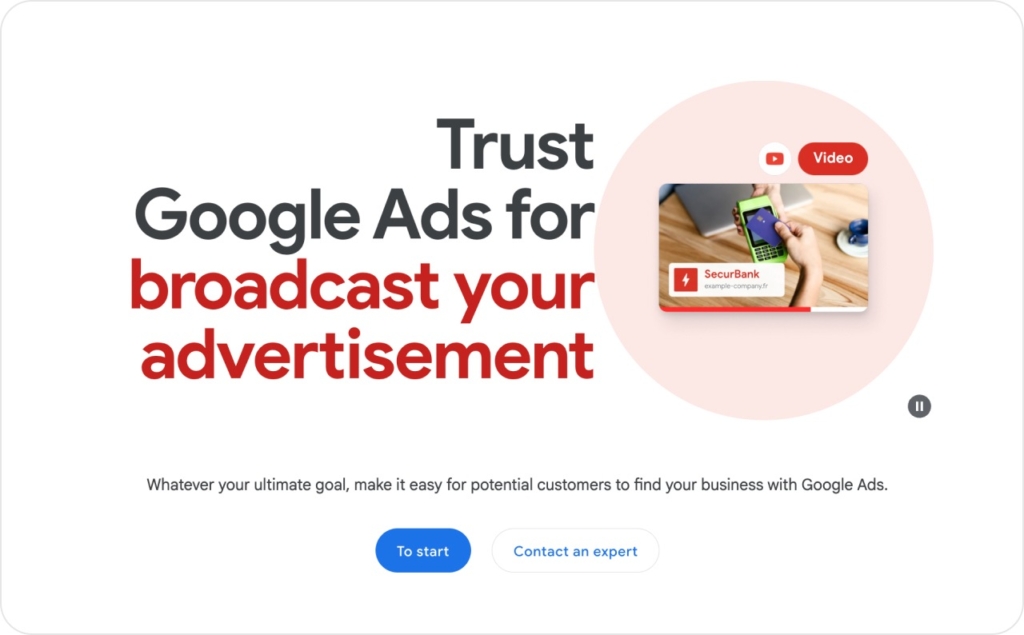
Photo source: Google Ads
How you can use AI to get better ad results
AI ad generator helps you cut wasted ad spend and boost results. Statista says automating customer interactions is one of the top ways marketers use AI worldwide. You can also apply it to lower costs, improve targeting, and focus on big-picture strategy, all without overhauling your entire process.
Most programmatic platforms, like Google Ads and Meta Ads Manager, already include built-in machine learning features. Tools like Smart Bidding or Campaign Budget Optimization can be turned on with just a few clicks. If you’re new to AI, don’t worry, these systems are designed to scale with your budget and experience.
How to optimize campaigns with real-time bidding
Manual bidding often reacts too late to matter. You only spot issues after the budget’s already been spent. AI solves this with automated bidding systems that respond in seconds. They adjust to changes in user behavior, device type, or audience engagement, keeping you efficient and maximizing ROI.
AI platforms analyze past interactions like page views and purchase history to predict who’s likely to convert. Using predictive models like regression or reinforcement learning, they optimize for purchases, leads, or ROAS. Bids increase with strong engagement and drop when performance lags, preserving your budget.
AI isn’t magic, it needs good data and clear goals. You still need to track key metrics like CPA, CTR, or CPC to know your optimization strategies are working. Check performance regularly and use manual oversight to spot issues. AI is smart, but it works best with human direction.
Adjust your settings during big promos or seasonal peaks. The AI will scale bids automatically, helping you capture more traffic at the right moment. That’s the power of data-driven optimization, fewer manual updates, better performance, and the flexibility to pivot fast.
Pinpoint your audience and personalize ads with AI
Dynamic creative optimization automatically changes ad elements, like headlines or images, in real time based on who’s viewing the ad. As programmatic advertising evolves, AI has become a key breakthrough. It automates buying and helps you target specific demographics more precisely, even if you’re on a budget.
Most tools like Google Ads, Meta Ads Manager, or Shopify come with built-in AI features. You don’t need to code or hire a developer. These platforms let you plug in quickly and start optimizing right away. That means relevant, responsive ads, without the heavy lift.
You’ve likely seen ads that feel made for you. That often comes down to AI audience segmentation and dynamic content optimization. With segmentation analytics, you can split audiences into smaller groups based on interests or purchase history and personalize dynamically without draining your time.
Here’s how it works. AI collects signals like page views or return visits. It builds machine learning segmentation clusters, then runs automated creative testing. You still set your brand voice and messaging rules, but ad creative automation decides which asset to show each user, based on performance data.
For example, one user might click on playful photos, while another responds to discounts. The system adjusts creatives instantly. Tools like Adobe Target, Google Optimize, or creative testing platforms help you manage segments and measure outcomes, all in one dashboard.
Start with a dynamic ad in Meta’s Ad Manager using Advantage+ placements. Then track metrics like CTR, CPA, and ROAS to see what works. With data-driven behavior targeting and dynamic creative optimization, you’ll reduce wasted impressions and deliver more relevant ads to each viewer.
This AI personalization means you’re not blasting one generic ad to everyone. Instead, you’re using advanced segmentation and letting the system automate creative, so each person sees what connects with them. You’ll earn stronger click-through rates, build brand loyalty, and get more value from your ad budget.
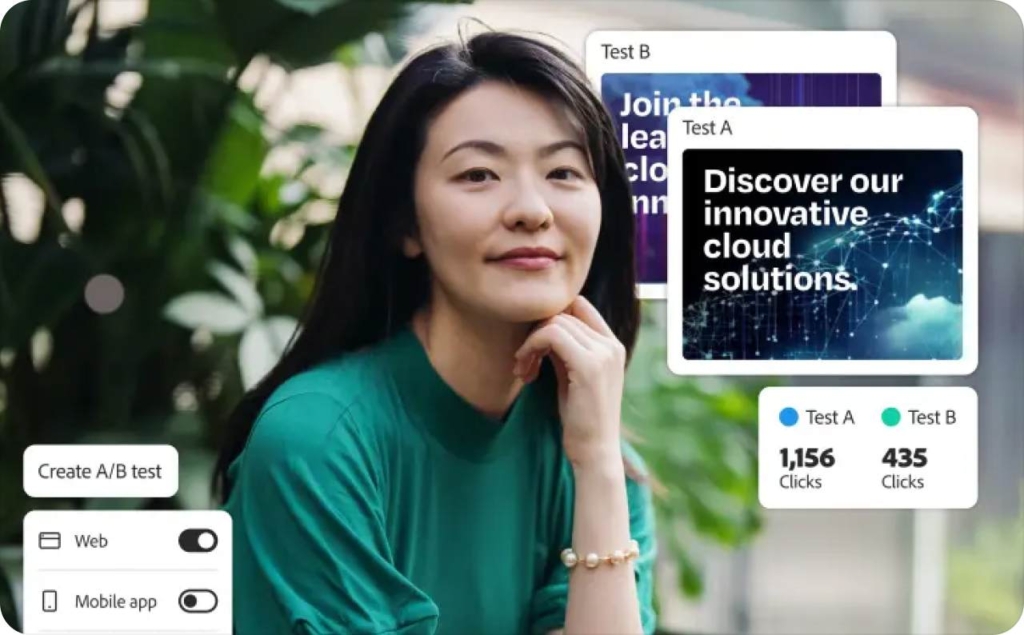
Photo source: Adobe for Business
How AI tools protect you from fraud
AI fraud detection in advertising uses smart algorithms, like anomaly scoring and bot detection, to catch fraud before it drains your budget. Fraud is growing fast: global costs may rise from $88 billion to $172 billion by 2028.
These systems collect device fingerprints, user behavior patterns, and engagement metrics, then compare them against benchmarks from secure ad networks. If they see red flags, like traffic spikes from unknown regions, they trigger a deeper review. Once confirmed, AI blocks threats immediately.
Platforms like Zeely work with Google, Meta, and major DSPs, offering live dashboards that show flagged activity. You stay in control, reviewing suspicious traffic and managing your ad network more safely. You can act fast, keeping fraud from wasting your ad spend and protecting your campaign’s performance.
Quality assurance goes beyond blocking bots. AI tools also verify ad placements, so your brand appears only on safe sites. They examine post-click behavior, filtering out empty traffic and ensuring real engagement. The numbers’ll show better click-through rates and a stronger signal-to-noise ratio.
You don’t need a big team or deep tech skills to work. Most AI fraud tools are plug-and-play, with simple onboarding for both small businesses and larger brands. When a click surge looks off, the AI flags it instantly. That means faster reactions and smarter decisions without needing constant manual monitoring.
This mix of risk mitigation and AI-driven insights keeps your data integrity intact and your ad spend on target. You stay focused on growth while the system hunts bots in the background.
Use AI to keep up and create smarter ads
AI is transforming not just how ads are delivered, but how they’re created. If you want to make more content, faster, and still speak to each customer personally, generative AI is your next best tool. That’s why using generative AI for advertising helps small teams scale with less effort and more impact — creating everything from copy to visuals quickly and efficiently.
How you can use AI to make content
Generative AI for advertising lets you create content automatically with tools like ChatGPT, DALL·E, and Stable Diffusion. These machine learning models generate visuals, copy, and campaigns at scale. You can build multiple personalized ads using AI-driven creativity and creative automation, tailored to your audience in real time.
Heinz proved the power of generative AI with its “AI Ketchup” campaign. Using DALL·E 2 and Midjourney, they prompted the word “ketchup,” and the AI kept generating bottle designs that resembled Heinz. The campaign’s social engagement rate beat benchmarks by 38%.
You can use generative AI to create email subject lines, social captions, or language-specific ads that adapt automatically. That’s mass personalization, real-time updates based on audience needs. It doesn’t replace your creative team. It helps them test more ideas and reduce time spent on repetitive tweaks.
Tools like Jasper, Runway ML, and Zeely offer no-code interfaces and easy templates. You can upload your brand voice, style guide, and tone preferences to stay consistent. These tools let you scale creatives without needing design or dev skills, just a clear direction and the right inputs.
Without clear guidance, Generative AI can generate off-brand or low-quality content. Ethical concerns also matter, like content bias and ownership. That’s why smart marketers pair AI tools with human oversight and review workflows. Let AI handle speed while you protect the tone, vision, and brand values.
Generative AI is changing how teams work and will soon be more personalized, predictive, and integrated across tools. Start small. Try one tool, run a pilot, and see what works for your audience. The future belongs to marketers who personalize content, move fast, and lead with creativity.
How AI can help you predict and target the right audience
Predictive analytics in advertising uses AI and past campaign data to forecast future user behavior. Instead of guessing what might work, you get real insights about who to target, when to reach them, and with what message.
AI systems start by collecting data from past results, like purchase behavior, engagement, or browsing history. That’s the “collect” phase. You feed the system relevant signals, and the machine learning begins, setting the foundation for targeting accuracy and deeper audience segmentation.
Next, algorithms like logistic regression, decision trees, or neural networks look for trends. These models predict who’s likely to convert and which messages might resonate. You move from guesswork to data-driven targeting that learns and adapts with every impression.
Then, AI uses these predictions to segment audiences and deliver ads across multiple channels — social, display, search, or email. It ensures the right people see the right message at the right moment.
According to Adobe’s 2025 Digital Trends Report, 71% of consumers want brands to anticipate their needs, but only 34% of brands do. Don’t worry. Predictive analytics isn’t just for big tech companies. Small businesses and solo marketers can also see results with simple tools and modest budgets.
If you don’t have a huge data set, that’s okay. Many AI platforms perform well with limited inputs and learn over time. Just remember: clean data matters. Without reliable signals, even the best predictive model can get it wrong.
Tools like Salesforce Einstein, Google Ads’ Smart Bidding, and Meta Advantage+ have built-in predictive features that shift spend toward high-likelihood converters. Track key metrics like CTR, CPC, CPA, and ROAS to see what’s improving. The more your campaign runs, the smarter your targeting models become.
If you want better targeting without hiring a data science team, try predictive analytics. Start with a small lookalike audience or retargeting pilot, watch the numbers, and tweak as needed. By blending AI insights with real marketing instincts, you’ll reach high-value users and create personalized campaigns that convert.
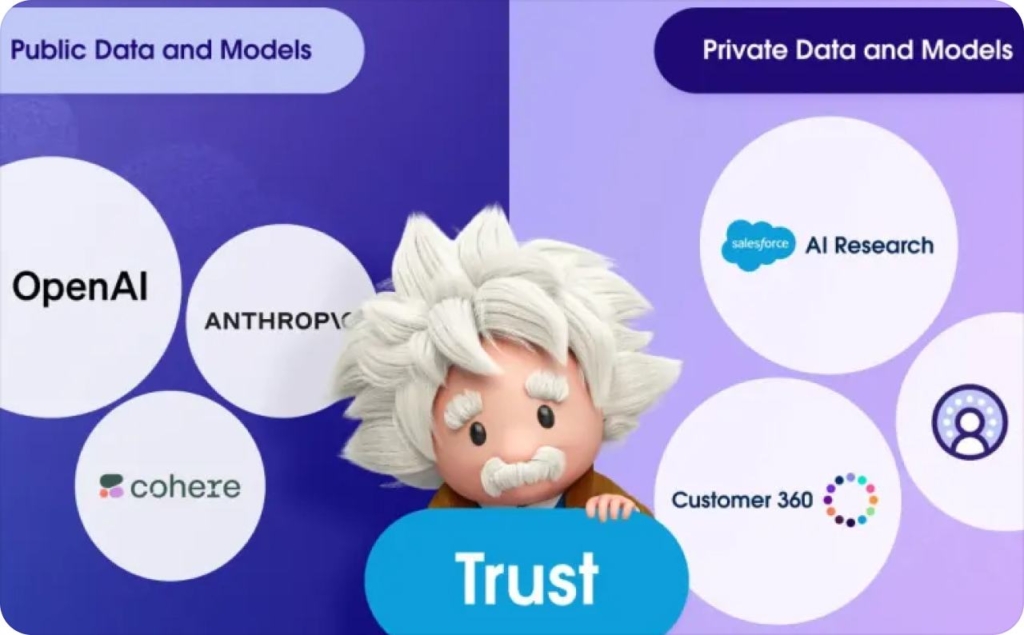
Photo source: Salesforce Artificial Intelligence
Why user privacy and ethical AI matter
Ethical AI in advertising means using automated systems and user data responsibly. In programmatic advertising, you’re not just optimizing bids — you’re handling private data. If users don’t understand how their data is used, that trust breaks down. That’s why data privacy must be part of every AI strategy.
Confusion about data use leads to lost trust. That’s where data privacy in programmatic advertising becomes essential. Responsible AI practices protect both your audience and your brand. Tools like the IAB Europe Transparency & Consent Framework help brands manage data ethically.
GDPR compliance is just the beginning. More regions are setting data laws. Use cookie consent tools, clear opt-outs, and anonymized IDs. If your AI automates decisions, you might also need to update your privacy policy. Map your data flows to see where sensitive information lives.
You don’t need a legal team to do this. Many ad tech platforms offer simple tools for small brands. Encryption, access controls, and basic privacy regulation practices help you stay compliant. These steps build data integrity and prepare for audits or user complaints.
Ethical AI also means managing bias. Run model audits, use balanced data, and set up review processes. If you’re a small business, start with one AI-driven segment or campaign. This shows you can be innovative and compliant, building trust while still hitting performance goals.
Start by reviewing your data flows — know who collects, stores, and shares user info. Audit your AI models regularly to catch bias. Update your privacy policy to explain AI usage. Follow frameworks like the IAB Europe TCF or local consent management laws to stay compliant and transparent.
Signs Your Ads Are Out of Compliance
- Your site doesn’t include a clear cookie consent banner
- You don’t know who can access your user data or how it’s stored
- Your AI ads make demographic assumptions without safeguards
- Your privacy policy hasn’t been updated to reflect AI usage
Even small changes, like adding opt-outs or running a model check, build ethical marketing practices. With transparent policies and regular oversight, you show users that their privacy matters. You stay on the right side of compliance and lead with responsible AI.
Now is the time for AI in ads
AI is driving the digital transformation of programmatic advertising. With data-driven insights, you can future-proof campaigns, cut waste, and adopt new ad technology trends. Instruments like predictive analytics and generative AI offer a clear competitive advantage in today’s crowded digital space.
Forward-thinking marketers are already adapting. Now’s the time to review your programmatic strategy, check your data readiness, and begin testing. Try tools like Meta Advantage+, which uses machine learning to optimize creatives and placements. Don’t do an overhaul — start where the return looks strongest.
When you focus on innovation and apply AI with intention, you create a strategy built for growth. Assess your tech stack, clean up your data, and align goals to real outcomes. Add a focus on measurable impact, and your campaigns stay agile, ready to scale and shift as the market evolves.
Also recommended

